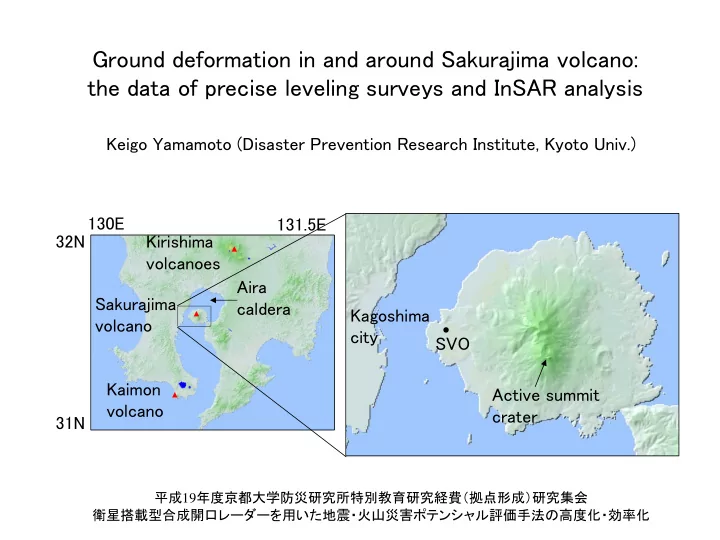

Ground deformation in and around Sakurajima volcano: the data of precise leveling surveys and InSAR analysis Keigo Yamamoto (Disaster Prevention Research Institute, Kyoto Univ.) 130E 131.5E 32N Kirishima volcanoes Aira Sakurajima caldera Kagoshima volcano city SVO Kaimon Active summit volcano crater 31N 平成 19 年度京都大学防災研究所特別教育研究経費(拠点形成)研究集会 衛星搭載型合成開口レーダーを用いた地震・火山災害ポテンシャル評価手法の高度化・効率化
Explosive eruption at the active summit crater Nov. 13, 2002
Eruptive activities at the active summit crater of Sakurajima volcano since 1955 4000 (10 4 tons) Yearly weights of estimated ash-fall deposits 3000 Observation 2000 Start 1000 0 1955 1960 1965 1970 1975 1980 1985 1990 1995 2000 2005 600 (Number) Yearly number of explosive eruptions 500 400 300 200 100 0 1955 1960 1965 1970 1975 1980 1985 1990 1995 2000 2005
Typical ground deformation patterns of Sakurajima volcano Inactive stage of summit eruption: inflation beneath Aira caldera (about 25cm uplift around northern part of Sakurajima) → magma storage at the reservoir beneath Aira caldera Active stage of summit eruption: deflation beneath Aira caldera and Sakurajima (about 23cm subsidence around northern and central part of Sakurajima) → pressure decrease at the reservoirs beneath Aira caldera and Sakurajima due to excess magma ejection (after Eto et al., 1997)
Relations among (m) Relative height of BM-S26 referred to BM-S17 1.80 405.60 BMSVO secular changes of (Caldera uplift) 1.70 405.50 relative heights of BMs and eruptive 1.60 405.40 activities at the 1.50 405.30 active crater of Sakurajima volcano 1.40 405.20 1955 1960 1965 1970 1975 1980 1985 1990 1995 2000 2005 4000 (10 4 tons) Yearly weights of estimated ash-fall deposits S26 3000 Observation 2000 Start 1000 S17 BMSVO 0 Minamidake 1955 1960 1965 1970 1975 1980 1985 1990 1995 2000 2005 crater 600 (Number) Yearly number of explosive eruptions 500 400 300 2km 200 100 0 1955 1960 1965 1970 1975 1980 1985 1990 1995 2000 2005
InSAR results by using JERS-1 data (after Okuyama et al., 2001) 9401 | 9703 9508 | 9808
Leveling survey 2007 Observation period: 2007/10/01-11/06 (Geographical Survey Institute) 2007/12/03-12/11 (University group) (km) (km) Leveling bench marks
Vertical displacement Data: 2006/06, 09 ~ 2007/10-12 (University and GSI data) Reference bench mark: S.17 Sakurajima North Coast 10.0 10.0 Sakurajima South Coast Vertical displacement (mm) Sakurajima Western Flank Aira Caldera East Coast 5.0 5.0 0.0 0.0 0.0 10.0 Dist. from S17 (km) -5.0 -10.0 -15.0 0.0 10.0 20.0 30.0 40.0 50.0 Distance from S17 (km)
(km) Pressure source (Mogi’s model) Depth = 14.6 km Vertical displacement above the pressure source: +19.1 mm Deformation volume at the (km) pressure source: +1.7×10 7 m 3 Correlation coefficient: 0.940 Vertical displacement (mm) Pressure source location is shown by the solid circle. Contours are the correlation coefficients between data and theoretical curve at the depth of 14.6km. Distance from pressure source (km)
ALOS/PALSAR interferogram Data Master: 2007/11/12 Slave: 2006/09/24 ( ← nearly leveling period) FBS mode Ascending Off nadir angle: 34.3 deg. Bperp ~ -1700 m
Expected InSAR image calculated by using the pressure source from Area 2 leveling data. Area 1 ↓ Average pixels in 500m × 500m area: Area 1 = -1.51 cm Area 2 = -0.19 cm ↓ This preliminary result is consistent with the Mogi ’ s model calculation.
Summary We conducted the precise leveling survey in Sakurajima volcano and around the Aira caldera during the period from October to December 2007. The last survey had been conducted in June and September 2006. The obtained survey data indicate the ground uplifts at the northern part of Sakurajima during the period from 2006 to 2007. From the analysis according to Mogi’s the model, the inflation source is located beneath the northern flank of the volcano, suggesting that the magma storage at the deep magma reservoir is progressed during the study period. ALOS/PALSAR image pair is selected to analyze so as to compare the ground deformation with that from the leveling data analysis. The resultant interferogram is seem to be consistent with the theoretical one that is calculated by using Mogi’s source, although the ground deformation is minor during this study period. Acknowledgement: PALSAR level 1.0 data are shared among PIXEL (Palsar Interferometry Consortium to Study our Evolving Land surface), and providing from JAXA under a cooperative research contract with ERI, Univ, Tokyo. The ownership of PALSAR data belongs to METI and JAXA.
Recommend
More recommend